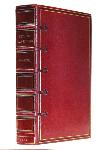Hell's Playground. New York: The Macaulay Company, 1914.
Octavo [x], 447 pp., with one page publisher's ads. Bound in full crimson crushed morocco by Macdonald, spine in gilt and black in six compartments, five raised bands, covers ruled in black and gilt, turn-ins ruled in gilt, marbled end-papers. Faint rubbing to extremities, front hinge cracked but sound. A near fine copy in a lovely binding.
Early printing of this classic pulp novel, originally published in 1912.
Hell's Playground tells the story of a beguiling African femme fatale who causes the downfall of the white men who are inexorably drawn to her. A cautionary tale of the dangers of miscegenation, the novel was the basis for the 1942 Hedy Lamarr film White Cargo. The taboo subject matter violated the Hays Code, and Lamarr's character had to be changed to Egyptian and Arab ancestry before the film could be made.
Interestingly, the book might never have been written were it not for the murder of renowned architect Stanford White and the sensational trial that followed. White was murdered in 1906 by millionaire railroad heir Harry Thaw, who was angry over White's romantic history with Thaw's wife, model and Gibson Girl Evelyn Nesbit. Simonton, a close friend of Nesbit's mother, was subpoenaed to testify in what was dubbed "The Trial of the Century", but fled to Paris, where she joined an expedition bound for Africa. Simonton's experiences in Africa, and what she considered to be the "degeneration" of the whites there, inspired her to write Hell's Playground upon her return.
"New African Trip for Ida Simonton", New York Times (2 Oct. 1914), 11; "Witness Against Thaw", New York Times (13 Nov. 1907), 4.
ID:
7383
$
200
